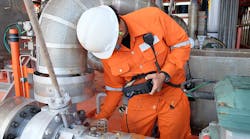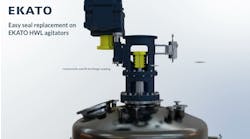The reliability and integrity of equipment, structures and piping can suffer because of vibration and dynamic responses. These depend mainly on excitation forces, stiffness, mass distribution and damping.
Modal analysis, which focuses on natural frequencies and associated modal shapes, provides an important tool in understanding potential issues. Indeed, usually the first step in checking for or troubleshooting vibration issues is to use it to find the natural frequencies and associated modes of machinery or systems. It can show if a specific excitation arrangement can excite a nearby natural mode. Such information then informs adjustments such as stiffening to ensure the natural frequencies lie outside the range of excitation frequencies. Sometimes, a natural frequency and an excitation frequency being close may be acceptable if the situation won’t cause a resonance and subsequent high vibration or damage.
Here, we’ll look at modal analysis and its application at processing facilities as well as practical pointers for avoiding problems.
Vibrational Modes
The first vibrational mode usually is related to the weakest part in a structure or piping or the most flexible component in a piece of equipment. For example, many machinery mechanisms rely on a small diameter shaft that carries a lot of weight or is under considerable loading. The deformation of this shaft typically indicates the first mode at work. With equipment having a long beam taking the main loading, the first mode is the bending mode of this beam. Many important modes are related to deformations under bending, torsion or a combination of the two. Often, an important mode is a combined one of deformation of two or three different components or parts such as two shafts or a shaft and an arm. In piping systems, a combined mode may involve two or three connected piping lines. The same is true for structures and frames.
Some modes, particularly first or second ones, can be easily excited. On the other hand, some modes need high energy for excitation. For instance, in a machine with a vertical cylinder in its base, the third mode is the slight bending of the vertical cylinder when the entire body of the unit oscillates. It is not easy to excite the machine at this mode. Many times, different local modes of oscillation occur for various components and subsystems. In such cases, the main elements of the machinery or structure stay stationary but some parts deform locally.
Certain high-order modes could be complex ones composed of bending and torsion of many or all the components in a piece of equipment, a piping system or a structure. On the other hand, some high-order modes could be second and third bending modes of different parts and components such as beams, arms, shafts, rotors, piping, etc. These high-order modes need specific (usually high energy) excitation arrangements — and, therefore, their excitation is unlikely. In other words, except in very rare cases, high-order modes don’t pose dangers. In addition, higher modes are quite damped in practice.
All-in-all, you should carefully check any equipment or structure for the first three modes.
Excitation Mechanisms
Forces resulting from operation, e.g., due to unbalance, misalignment, reciprocating motion, etc., can generate an excitation frequency close to a natural frequency. The relationship between generated forces and the speed in different pieces of equipment can be complex. There could be different harmonics of operating speed acting as excitation forces. So, check the harmonics of operational frequency and compare them with natural frequencies. The integer number of the fundamental operational frequency might come close to a natural frequency; this may lead to resonance, high vibration or even some damage if the excitation forces can excite a natural mode that’s close.
For instance, in one machine the rotor speed was around 11 Hz and the first natural frequency was 22.7 Hz. Two times the operational speed (2×11 Hz) was very close to the natural frequency and misalignment at that speed could be enough to excite the natural first mode, which was in the transversal direction. So, the machine was modified to elevate the first natural frequency to a higher value.
In some cases, you must modify the operating speed to avoid any resonance and achieve better operation with minimum vibration. To reduce the vibration, the excitation frequencies should be far from the modal natural frequency of the whole machinery system (including the associated structure, connected piping, etc.).
Reliable and high-performance operation also requires careful evaluation of overall and local vibrations and deformations. You must assess the deformation of equipment, structures or piping at each critical point where there is a limitation. For instance, if the gap between a moving part and stationary components is tight, you should check the vibration and deformation at that location to avoid any operational problems.
Calculation Caveats
Theoretical models nearly always exhibit stiffer behavior than actual machinery, piping or structures. Therefore, calculated natural frequencies usually are higher than the actual ones. This mismatch is lower than that between actual/measured modes and calculated ones. For a vibrating mode, the calculated natural frequency may be accurate but the theoretical predicated mode shape might not be. You should consider this in operational observations, reliability studies and maintenance.
Nonlinearities are a major reason for incorrect mode shapes. However, inaccuracies also stem from other sources such as damping. Because the values of damping aren’t accurately known, it’s difficult to theoretically predict the behavior of the machinery, piping or structure at or near resonance. Too often, this is where accurate simulations are needed to make important decisions on operation, modification and improvement. Prestressing can change the modal behavior of a structure, piping, frame and other elements.
Case Studies
Now, let’s look at two examples of the use of modal analysis.
Drive frame for belt conveyor. This very large belt conveyor for transferring raw material to a chemical plant has a speed of 5 m/s, a width of 2 m, and capacity of 6,000 t/h. The length of conveyor is 1,450 m. The drive frame has two pulleys, each driven by a 750-kW drive unit. This is a long, high-power system; there was concern about different dynamic and vibrational behaviors of such a conveyor and drive frame.
During the commissioning and initial period of operation, complaints arose about high vibration of the drive frame. A modal analysis conducted for the drive frame indicated the lowest modal frequency (first natural frequency) to be just above 3 Hz (somewhere between 3.1 Hz and 3.4 Hz in different simulations). The movement was in the transversal direction (in the axial direction of pulley shaft). Because the actual drive frame was softer (less stiff) than the finite element model, the actual natural frequency for this mode would be around 3 Hz. On the other hand, the rotational speed of the pulley was calculated as around 1.5 Hz. The excitation frequency caused by misalignment was two times the rotational speed, equivalent to around 3 Hz. This excitation acted in the same direction as the first mode — in the transversal direction, the axial direction of pulley shaft. This resonance was the reason for high vibration.
To solve the problem, the drive frame was stiffened to make the natural frequency more than five times higher than the excitation frequency. This required a very strong bracing configuration in the transversal direction (in the axial direction of pulley shaft) to elevate the first modal frequency to the targeted level.
The original design of the frame offered very little stiffness in the transversal direction because it was believed that the main loading was in the longitudinal direction. This was proved wrong.
One or two ordinary transversal braces or supports wouldn’t suffice. The fix required four strong box-type transversal supports, two at the top and two at the middle. Each was fabricated from 16-mm plate, placed inside an existing I-beam column and then fully welded all around. This solved the problem and eliminated the resonance and high vibration.
250-MW high-speed machinery package. This unit was mounted on a massive reinforced-concrete foundation supported on 15-m concrete piles that extend down to bedrock. The total weight of the machinery and foundation is around 2,000 tons. To satisfy operational and seismic requirements, a modal test and finite element analysis was carried out to obtain the natural frequencies and mode shapes of the machinery unit. Some assessments showed that the concrete columns were elastic for 5 m under the concrete floor and were assumed rigidly secured below this depth. Tests and calculations identified 20 modes between 3.8 Hz (fundamental, longitudinal–horizontal [x] direction) and 230 Hz (complex platform bending torsion). The first mode was 3.8-Hz, translational [x], in-phase, rigid platform. The second mode was 4.1-Hz, y-lateral, in-phase, rigid platform. The third mode was 5.1-Hz, y torsional, platform warping. The fourth mode was 9.5-Hz, y-lateral, platform bending. Higher modes showed further platform warping and column-versus-column bending. First operational excitations were considered; it was confirmed there was no resonance. Because this is a high-speed unit, the machinery’s contribution should be minor below 25 Hz, at which frequency any excessive rotating unbalance may couple with mode 7.
For seismic considerations, a considerable amount of the excitation energy is in the 1–10-Hz frequency range. The most significant vibration responses are expected to occur in modes 1 and 2, because these modes most readily can couple with the strongest earthquake spectral components in the 1.5–6-Hz domain (which is the major excitation frequency range of historical earthquake data for the region). Above 7 Hz, the earthquake excitation strength is less, and the modal forms also are less likely to couple with the ground motions. For instance, column-versus-column modes are improbable with ground vibration as are platform warping and vertical modes. Further simulations for this structure showed that stresses and deformations as the result of an assumed “0.25×g” seismic load are below the allowable limits.
AMIN ALMASI is a mechanical consultant based in Sydney, Australia. Email him at [email protected].


